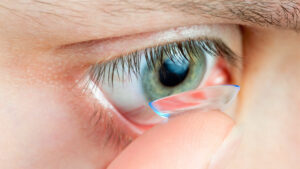April 17, 2023
By Dwight Akerman, OD, MBA, FAAO, FBCLA, FIACLE
 Soft contact lenses may help slow myopia progression in children, but eye care practitioners have been concerned about whether the risk of infection outweighs the potential benefits. In light of the increased interest in fitting myopic children with soft contact lenses, Bullimore and Richdale reviewed nine large prospective and retrospective studies that include data on the incidence of microbial keratitis and corneal infiltrative events (CIEs) in children wearing soft contact lenses.
Soft contact lenses may help slow myopia progression in children, but eye care practitioners have been concerned about whether the risk of infection outweighs the potential benefits. In light of the increased interest in fitting myopic children with soft contact lenses, Bullimore and Richdale reviewed nine large prospective and retrospective studies that include data on the incidence of microbial keratitis and corneal infiltrative events (CIEs) in children wearing soft contact lenses.
Seven prospective studies were identified between 2004 and 2022, with a total of 3,752 patient years of wear for 1,756 children, most of whom were fitted for contact lenses by age 12. Within these studies, there was one case of microbial keratitis and 53 CIEs (16 were considered symptomatic). The researchers reported an overall incidence of microbial keratitis of 2.7 per 10,000 patient years (similar to that of adults) and an incidence of symptomatic CIEs of 42 per 10,000 patient years, which is lower than in adults.
Two retrospective studies (2,545 patient years of wear; 1,025 children) reported children were fitted for contact lenses at age 12 or younger. One of these studies reported two presumed or probable cases of microbial keratitis, demonstrating an incidence of 9.4 per 10,000 patient years. The pooled 6,297 patient years from both prospective and retrospective studies resulted in a microbial keratitis incidence of 4.8 per 10,000 patient years with no cases of vision loss.
No contact lens wearer, including children, is immune to CIEs. Continued education regarding proper wear and care and appropriate and early response to adverse symptoms can further reduce the risk of long-term consequences. ECPs should ensure they educate all patients about modifiable risk factors, including not swimming or sleeping in soft contact lenses, not re-using or “topping off” cleaning solutions, and not extending contact lenses beyond the prescribed replacement schedule.
Soft contact lenses are the most frequently fitted lens type for children, and safety remains at the forefront in decision making for both ECPs managing pediatric patients and parents considering contact lens options for myopia management.
The researchers concluded that it is possible to make a valid assessment of the safety of soft contact lenses in children by assembling data from several studies. The prospective studies collectively represent 3,752 patient years of wear in children who were fit with soft contact lenses. The overall conclusion is that the incidence of CIEs in children is lower than in adults. Regarding microbial keratitis, the overall incidence in children wearing soft contact lenses is 2.7 per 10,000 patient years (95% CI: 0.5–15) — similar to that reported for adults.
Abstract
Incidence of Corneal Adverse Events in Children Wearing Soft Contact Lenses
Mark A Bullimore, Kathryn Richdale
Objectives: There is increasing interest in fitting children with soft contact lenses, in part due to the increase in prescribing of designs to slow the progression of myopia. This literature review summarizes large prospective and retrospective studies that include data on the incidence of microbial keratitis and corneal infiltrative events (CIEs) in children wearing soft contact lenses.
Methods: Peer-reviewed prospective and retrospective studies that report contact lens-related complications in children with at least one year of wear and at least 100 patient years of wear were identified.
Results: Seven prospective studies published between 2004 and 2022 were identified, representing 3,752 patient years of wear in 1,756 children, nearly all of whom were fitted at age 12 years or younger. Collectively, they report one case of microbial keratitis and 53 CIEs, of which 16 were classified as symptomatic. The overall incidence of microbial keratitis was 2.7 per 10,000 patient years (95% CI: 0.5-15), and the incidence of symptomatic CIEs was 42 per 10,000 patient years (95% CI: 26-69). Two retrospective studies were identified representing 2,545 patient years of wear in 1,025 children fitted at age 12 years or younger. One study reports two cases of microbial keratitis, giving an incidence of 9.4 per 10,000 patient years (95% CI: 0.5-15).
Conclusions: Accurate classification of CIEs is challenging, particularly in retrospective studies. The incidence of microbial keratitis in children wearing soft lenses is no higher than in adults, and the incidence of CIEs seems to be markedly lower.
Bullimore, M. A., & Richdale, K. (2022). Incidence of Corneal Adverse Events in Children Wearing Soft Contact Lenses. Eye & Contact Lens, 10-1097.
DOI: 10.1097/ICL.0000000000000976













